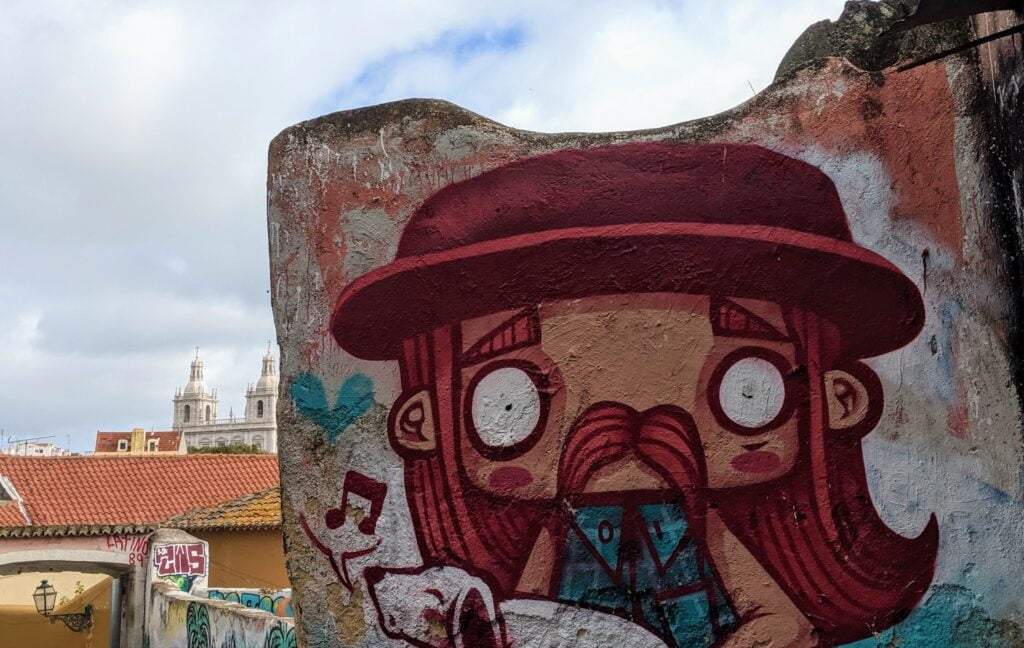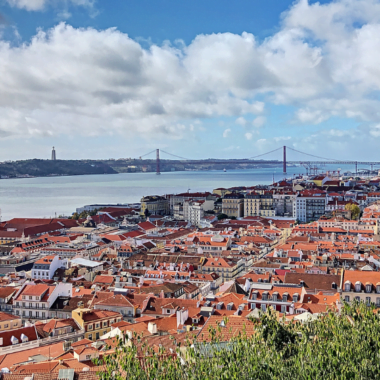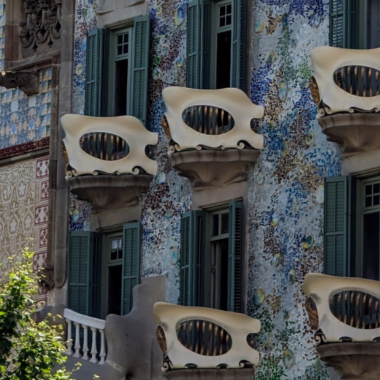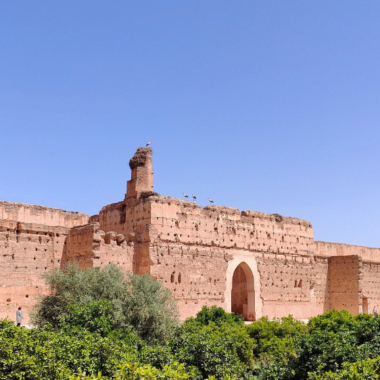On our itinerary for the first day of our city trip to Lisbon: exploring Alfama, Graça, and Mouraria. These three districts carry rich histories and local traditions.
Alfama, Graça, and Mouraria in a nutshell
Alfama and Mouraria, the ancient medina of Lisbon
During the Roman occupation, Alfama is a residential district predominantly inhabited by the upper echelons of society. This is evident through various archaeological remnants, including public Roman baths.
When the Moors invade Portugal in the 8th century, they transform Alfama to resemble the medinas of Casablanca, Marrakech, or Tangier. They construct a complex network of small alleys around the ancient citadel, designed as a defense system against the invaders. Meanwhile, the Mouraria district becomes the designated residence for the Muslim population (mouro meaning “Mauritanian” or “Moor”).
With the revival of Christianity in the 12th century, Alfama expand and transform into a residential quarter exclusively reserved for the Christian nobility. Meanwhile, the Moors are forced to leave the city or confine themselves within the walls of Mouraria. As a destitute neighborhood and the Moors’ ghetto, Mouraria later becomes the birthplace of fado and its melancholic melodies.
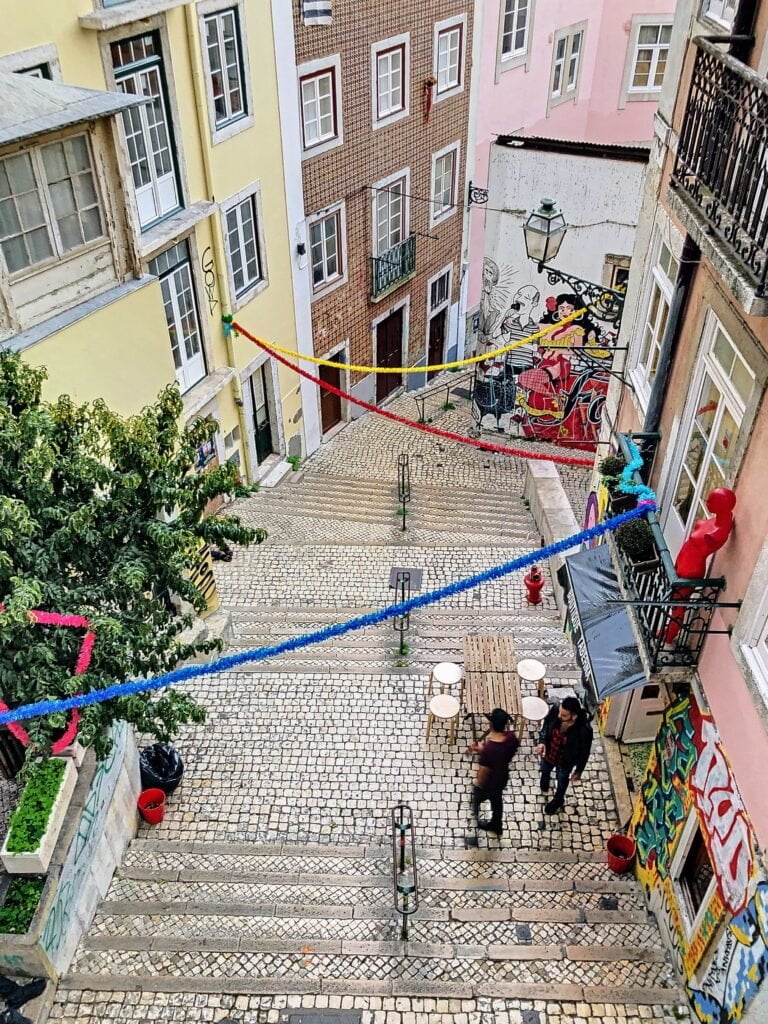
Despite being the only neighborhood that remarkably withstood the 1755 earthquake, Alfama witnesses its residents fleeing towards the western parts, seeking refuge from future seismic events. The affluent families make room for transient fishermen and sailors, yearning for a momentary respite before departing towards the new Portuguese colonies. Consequently, Alfama becomes synonymous with prostitution, criminality, and abysmal living conditions.
In half of the 20th century, the population of Lisbon experiences remarkable growth, leading to a housing shortage. As a result, Alfama welcomes many new residents, along with the influx of capital that helps restore the neighborhood. Gradually, the worn-out facades give way to shiny new buildings. The enchantment continues, but how much longer will it last?…
With its narrow and winding alleyways, colorful houses, staircases, and façades adorned with azulejos, Alfama is a picturesque neighborhood that embodies the very essence of Lisbon.
Over the centuries, Muslims, Jews, and Christians continue to live side by side in Mouraria, transforming the neighborhood into a true hub of multicultural exchange and encounters. However, during the 20th century, this area experiences periods of economic decline and poverty, leading to drug abuse and delinquency issues. Once infamous, Mouraria is now undergoing the same urban revival recently observed in Alfama, breathing new life into this vibrant community.
Despite the ongoing urban transformations, Alfama and Mouraria remarkably preserve their Moorish heritage, medieval charm, and vibrant local identity. With their winding alleys, colorful houses, and picturesque atmosphere greatly admired by visitors, these neighborhoods truly epitomize the essence of Lisbon.
Grace, authenticity, and breathtaking viewpoints
Perched on the highest hill in Lisbon, Graça is a district renowned for its tranquility, authentic atmosphere, and breathtaking panoramic views. It is nestled near Alfama and Mouraria and exudes a captivating charm that enchants visitors.
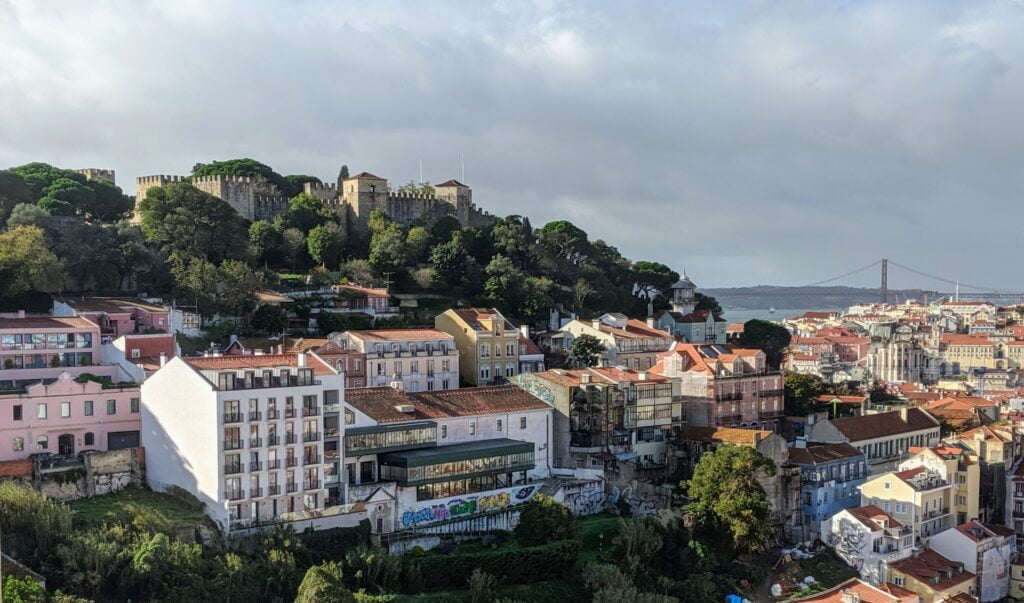
When Christian forces recapture Lisbon in the 12th century, Graça, much like Alfama, becomes a residential area for Christian society’s nobility and upper classes. The neighborhood owes its name to the chapel of Nossa Senhora da Graça, believed to have been built in the 13th century.
Over the centuries, Graça blossoms into a vibrant residential neighborhood, attracting a diverse population. It boasts the presence of churches, convents, and palaces, which only adds to its historical and architectural significance. However, like many neighborhoods in Lisbon, Graça endured significant damage after the 1755 earthquake.
Having undergone periods of transformation and urban development, Graça has managed to preserve its unique character and warm ambiance. Serving as the stage for festivals and numerous local celebrations, especially the Santo António festivities in June, the neighborhood is primarily sought after for its picturesque alleys and magnificent panoramic city views.
A Day’s Journey through Alfama, Mouraria, and Graça
Alfama, Mouraria, and Graça are all easily accessible by public transportation. From the city center, one can even reach Mouraria and Alfama on foot, enjoying a beautiful stroll through a maze of steep alleys adorned with colorful facades.
The suggested itinerary can be completed in less than two hours. However, do not hesitate to take the entire day to explore the 4-kilometer loop leisurely. You can truly appreciate their charming allure by getting lost in the labyrinth of narrow streets in Alfama and Mouraria 😍
Our Airbnb is located in the heart of Mouraria (Largo dos Trigueiros). We take a leisurely walk along Calçada do Marquês de Tancos and Rua do Milagre de Santo António towards our first viewpoint of the day. Many tourists avoid the uphill climb by boarding the famous Tram 28 😅
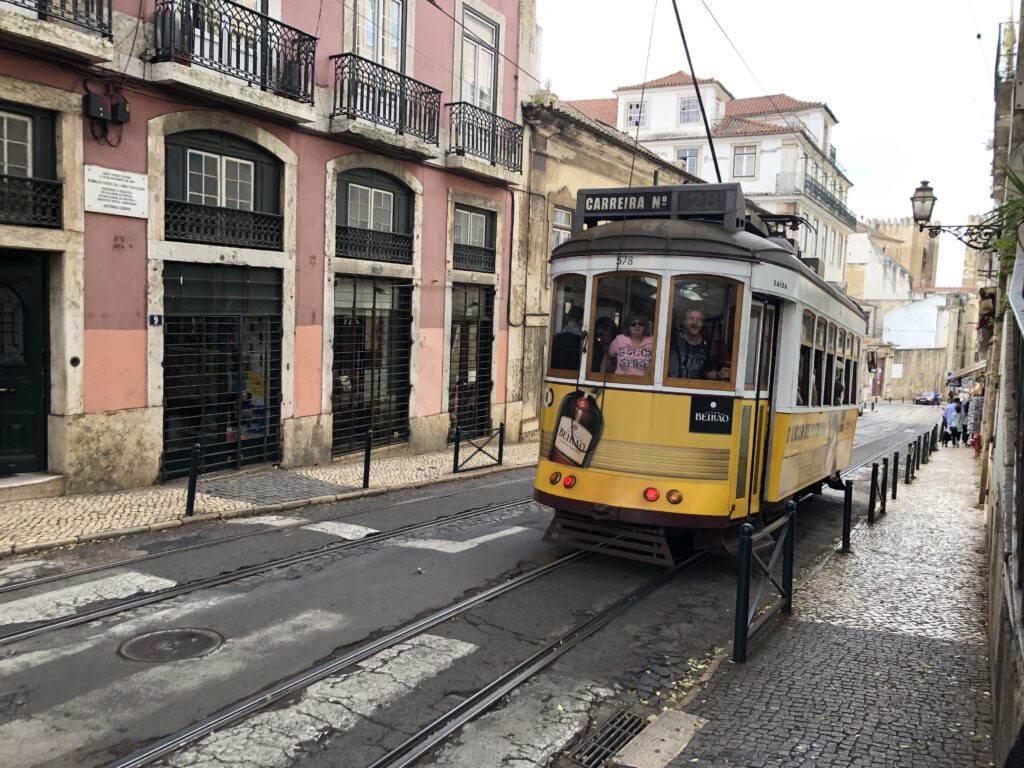
On the way, we stop for a delightful breakfast on the charming terrace of Audrey’s Cafe ☕
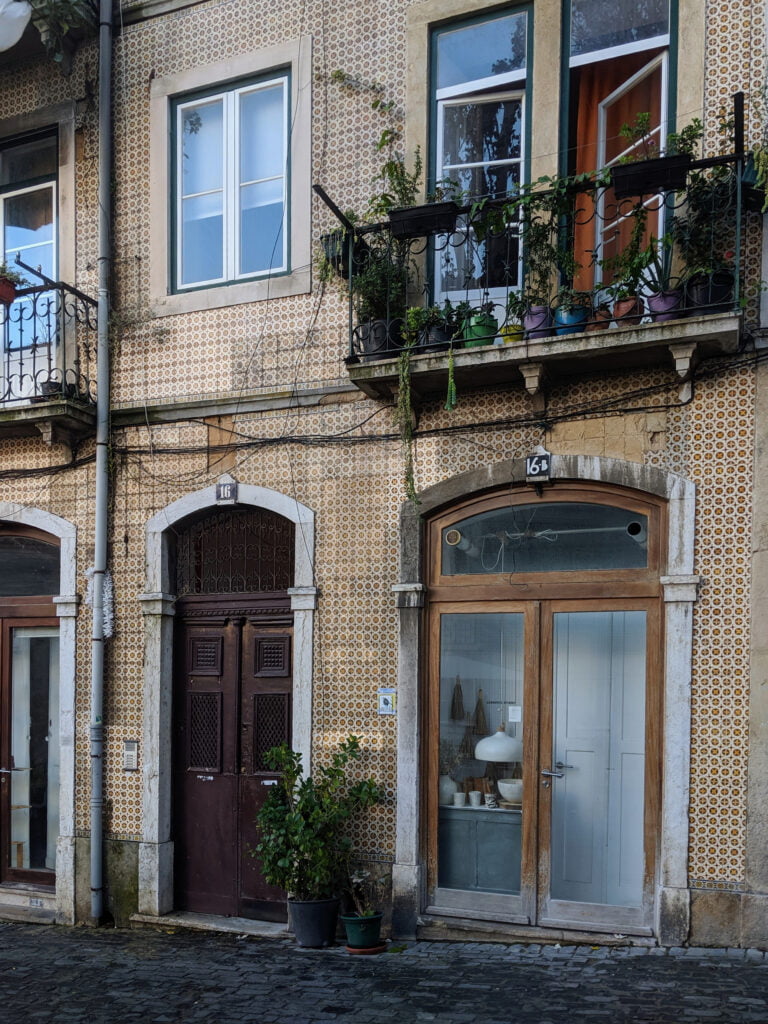

A few meters below, two belvederes provide a panoramic view of the city and the traditional houses of Alfama: the Santa Luzia viewpoint and the Portas do Sol viewpoint.
Miradouro de Santa Luzia
Located near the popular miradouro das Portas do Sol, the miradouro de Santa Luzia is a stunning viewpoint offering breathtaking views of the River Tagus and the red rooftops of Alfama. The characteristic viewpoints, from left to right, include the São Vicente de Fora monastery, the dome of the National Pantheon, the Santo Estêvão church, and the two white towers of the São Miguel church.
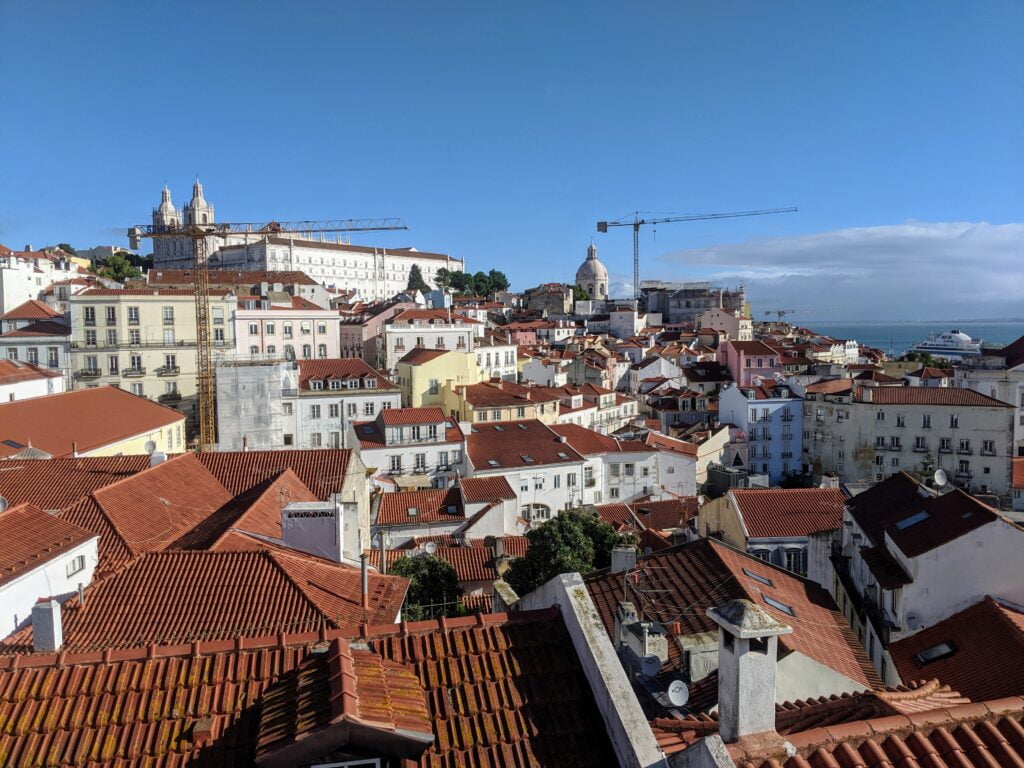
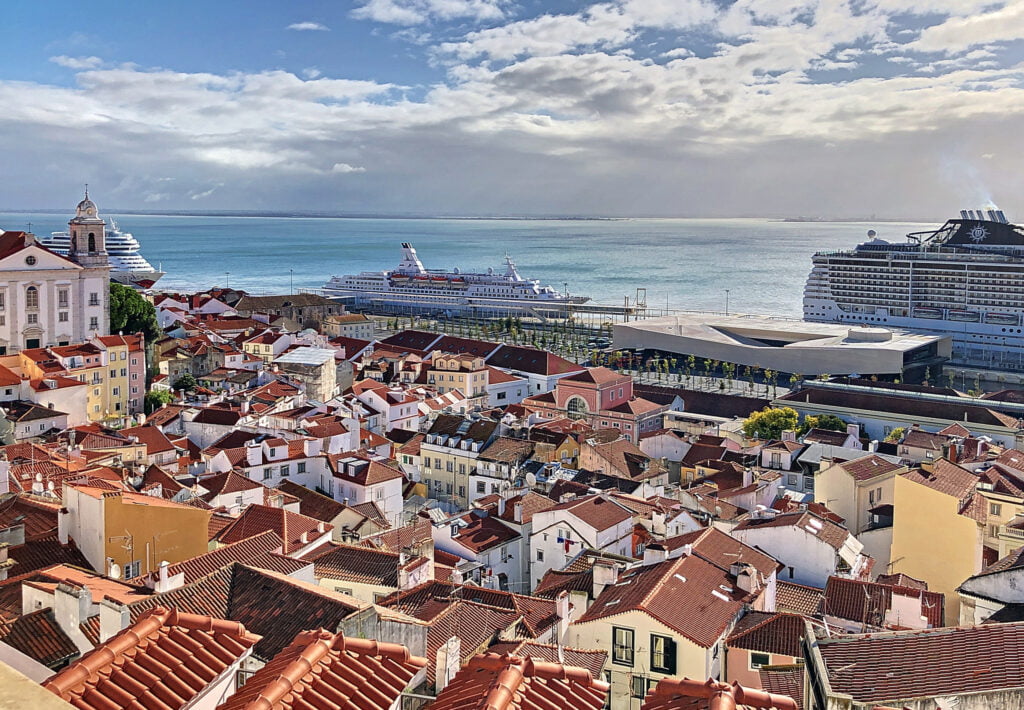
Santa Luzia’s belvedere is a true haven of peace, consisting of two levels. The first level boasts a vine-covered terrace adorned with columns, while the second level features a quaint garden surrounded by beautiful bougainvillea.
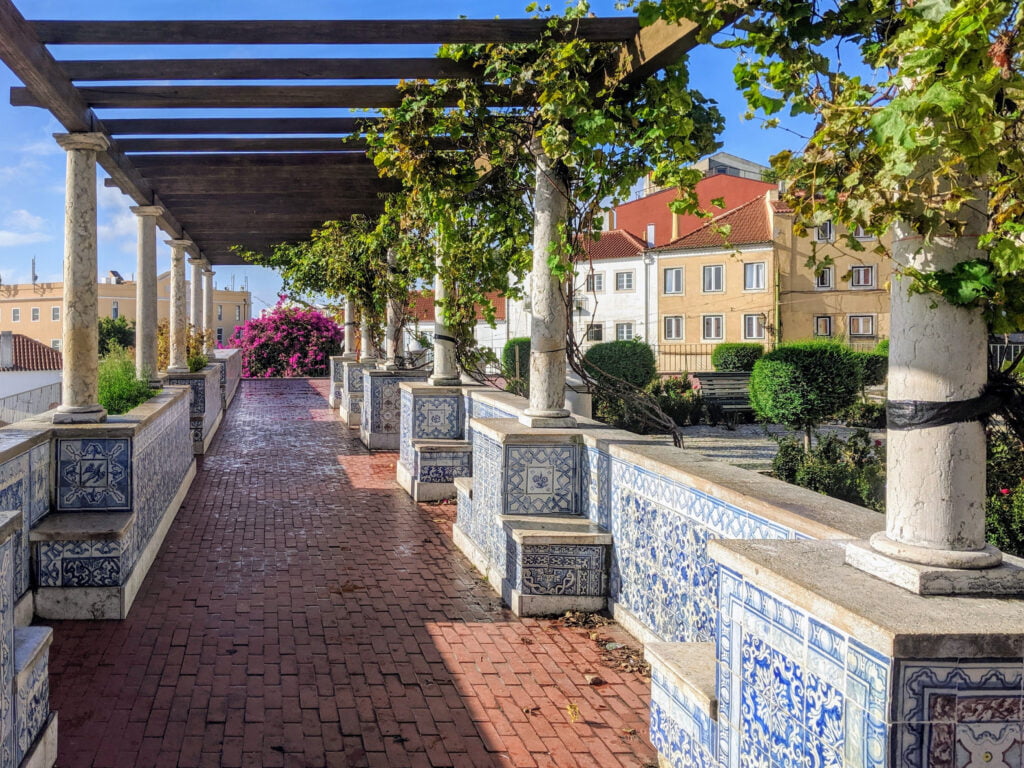
In the center of the garden, also known as Praça Júlio de Castilho, stands a bust of the renowned writer Júlio de Castilho, a distinguished chronicler of Olisipo, the ancient name of Lisbon.
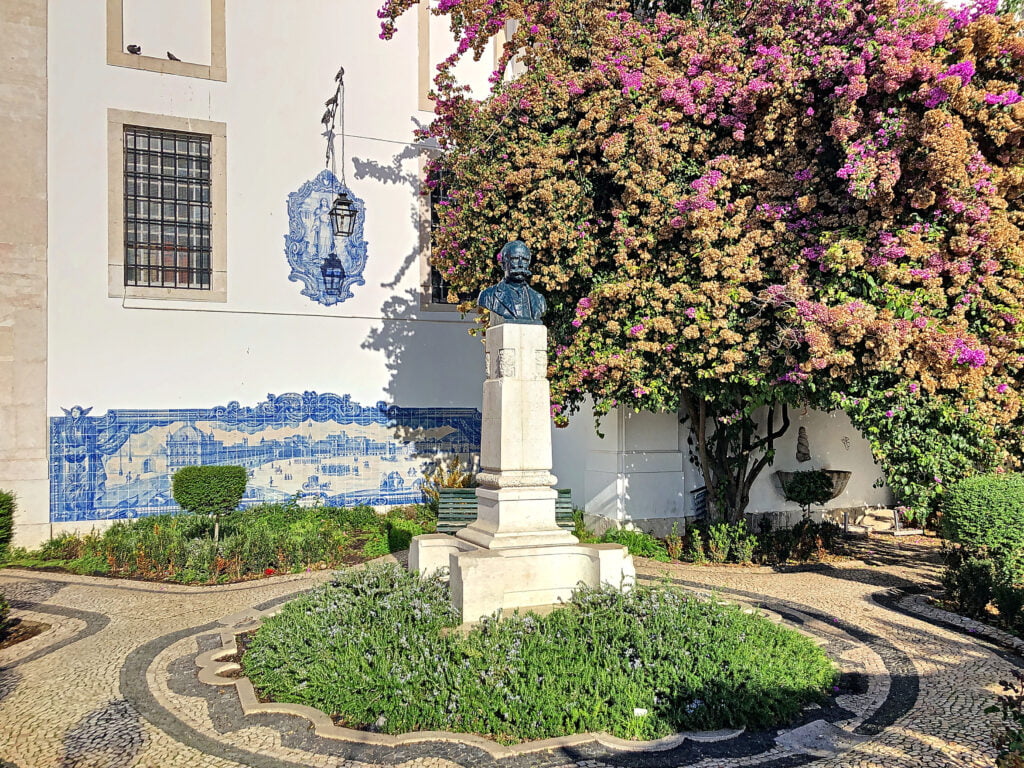
Dating back to the 18th century, the Church of Santa Luzia (Igreja de Santa Luzia) stands adjacent to the lookout point. Its south facade is adorned with two azulejos panels crafted by António Quaresma: one depicting the Praça do Comércio (Commerce Square of Lisbon) as it appeared before the 1755 earthquake, and the other capturing the capture of São Jorge Castle by the Catholics in 1147.
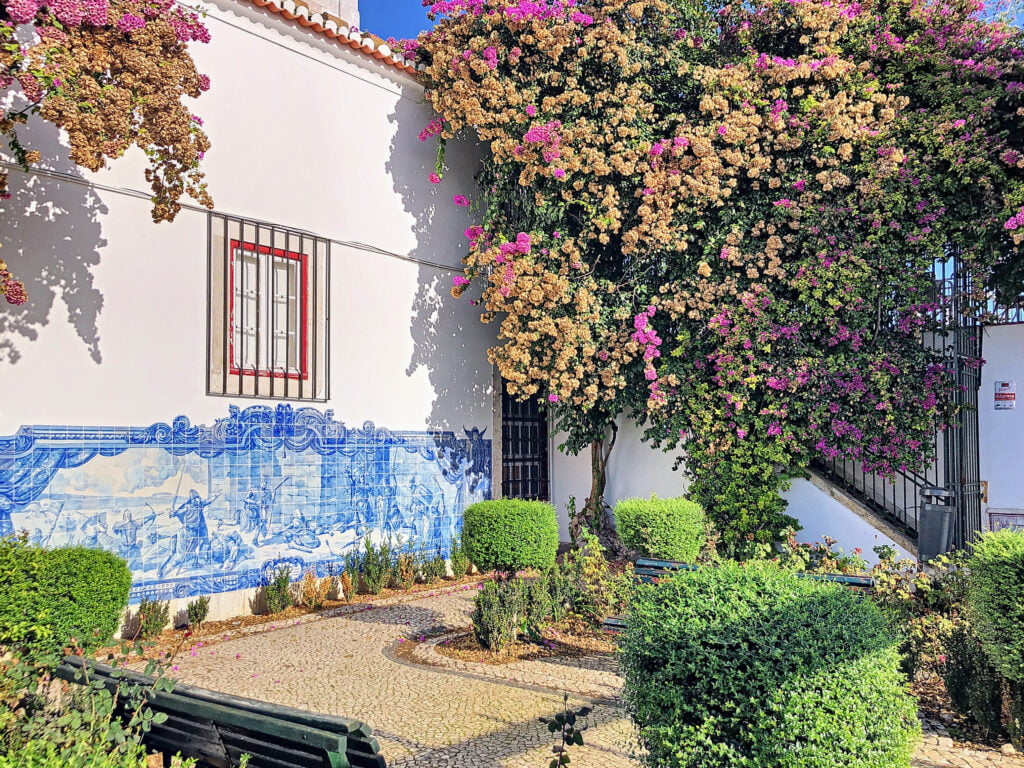
➜ Located just behind it, the view from the miradouro das Portas do Sol doesn’t differ much from the miradouro de Santa Luzia. However, taking the staircase that winds along the viewpoint is interesting to admire the History of Lisbon mural.
History of Lisbon
Painted in 2016 on both sides of the arch of a tiny tunnel, Nuno Saraiva’s mural, “History of Lisbon,” vividly portrays the story of Lisbon in a comic strip format.
Based in Lisbon, Nuno Saraiva is a Portuguese multidisciplinary artist renowned for his illustrations, drawings, and murals. Seamlessly combining graffiti, illustration, and street art elements, Saraiva’s style is characterized by expressive brushstrokes, vibrant colors, and witty characters. His works often explore themes related to popular culture, history, architecture, and the everyday life of Lisbon.
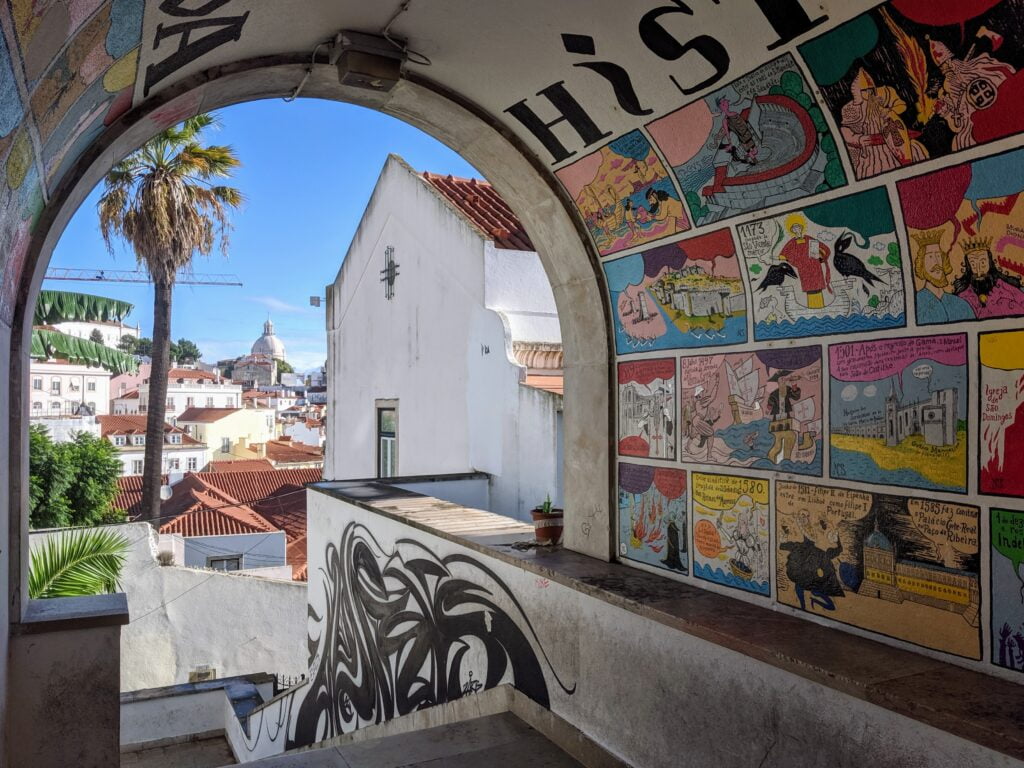
The mural begins with the founding of the city by the Phoenicians, delves into the Portuguese Inquisition, depicts the devastating earthquake of 1755, and concludes with the Carnation Revolution – the April 25th, 1974 coup d’état that reinstated democracy by overthrowing a dictator.
In 2021, the mural was vandalized, prompting students from the School of Art and Design in Caldas da Rainha to restore it, only to witness its subsequent damage again.
A few meters to the left, on Rua de São Tomé, there is a remarkable street art piece by VIHLS honoring the renowned fado singer Amália Rodrigues. Created in collaboration with the city’s team of pavers, using a traditional Portuguese style pavement, this artwork called “Calçada” (curb) pays tribute not only to the singer but also to the skilled artisans who, over time, have contributed to the development of decorative art that has become an integral part of Portugal’s visual identity.
Further down to the right, the narrow alleyway of Beco dos Loios turns out to be a series of stairs connecting Rua de São Tomé to Rua de São Vicente, leading towards the Monastery of São Vicente de Fora.
Mosteiro de São Vicente de Fora
The first Saint Vincent de Fora monastery, also known as Mosteiro de São Vicente de Fora, was established in 1147 by Alfonso I, the first Portuguese king. Located outside the city walls (de Fora meaning “outside the walls”), it is dedicated to Saint Vincent of Saragossa, the patron saint of Lisbon. During that time, it was one of the most significant monasteries in medieval Portugal. The current building, commissioned around 1582 by King Philip II of Spain, is a reconstruction erected on the site of the former medieval structure.
Built between 1582 and 1627, the monastery’s church (Igreja de São Vicente de Fora) showcases a majestic yet austere façade, adhering to the Renaissance style later known as Mannerism.
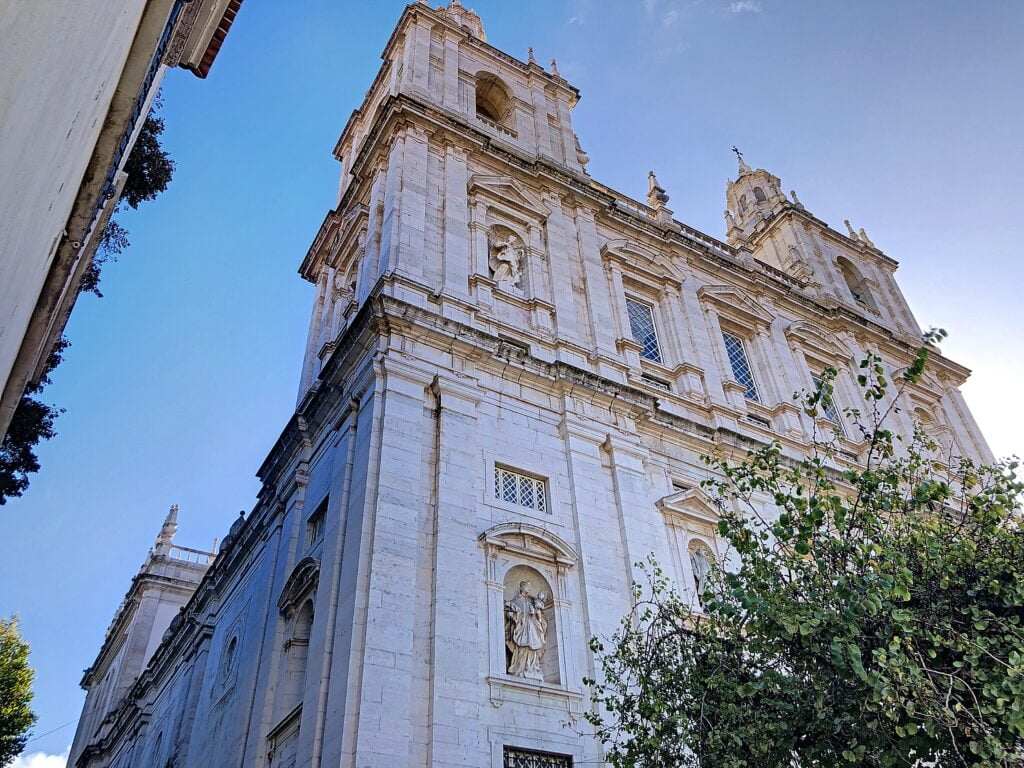
Next to the church, a splendid baroque gate provides entry to the monastery and its two cloisters.
With ogival arches, cloisters exemplify the impressive Manueline architecture, a Portuguese architectural style of the Age of Discovery. Adorning their walls are azulejos depicting various secular scenes inspired by French engravings, such as strolls, hunts, and fishing.
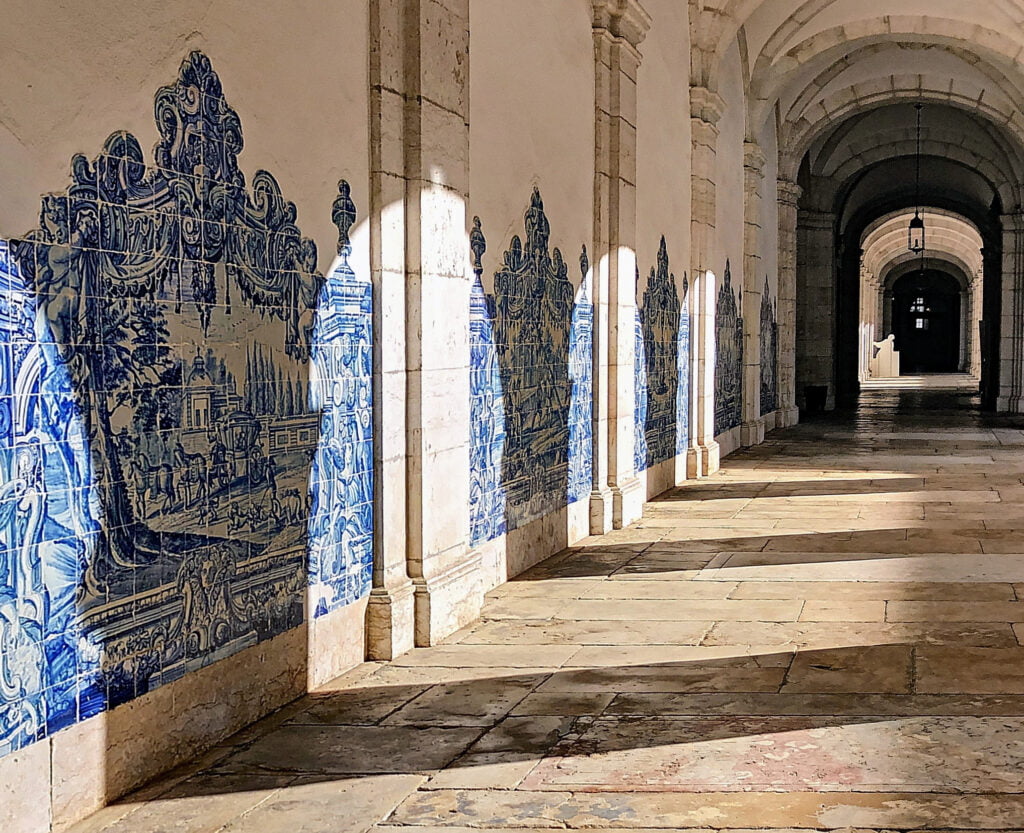
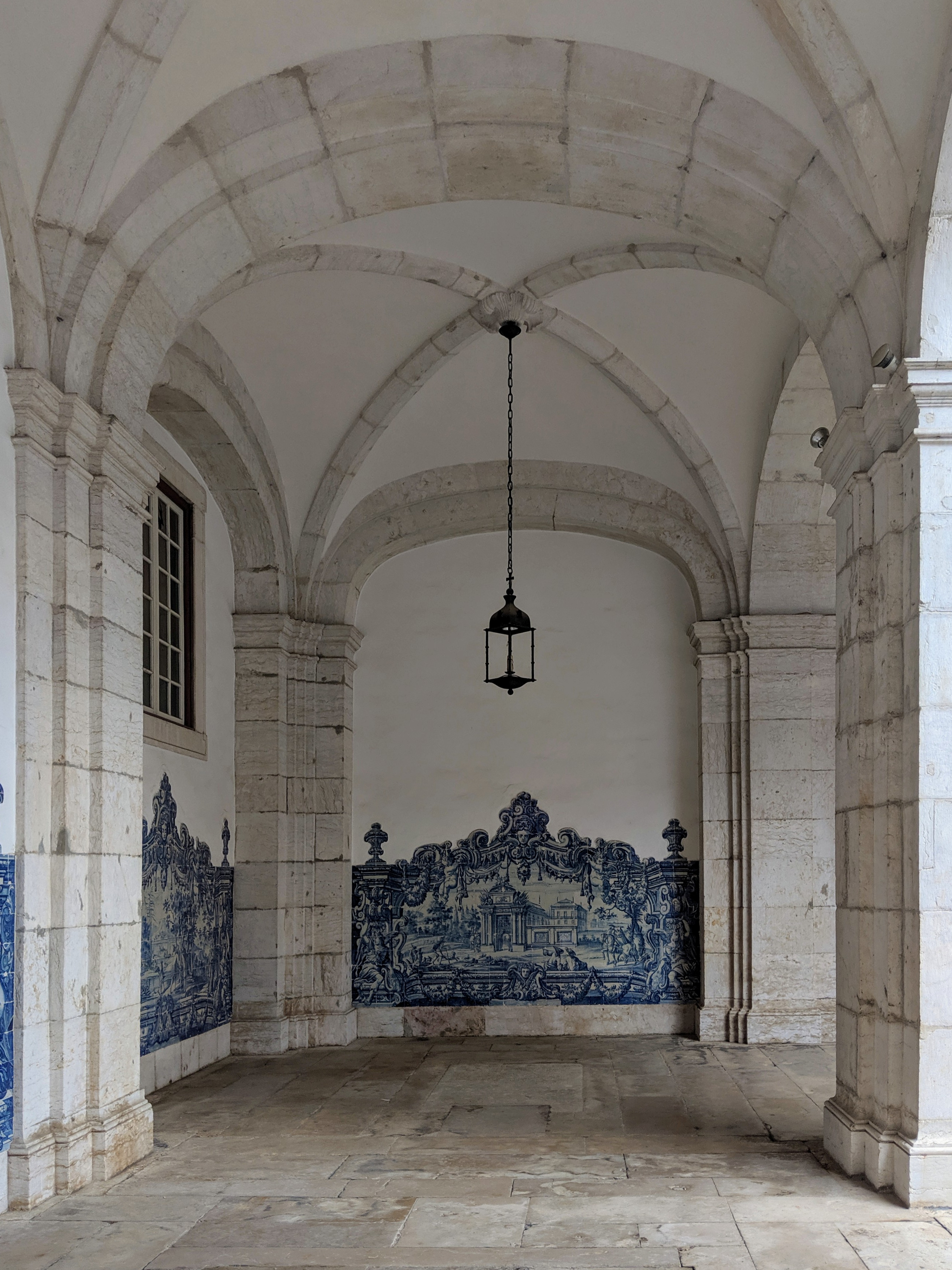
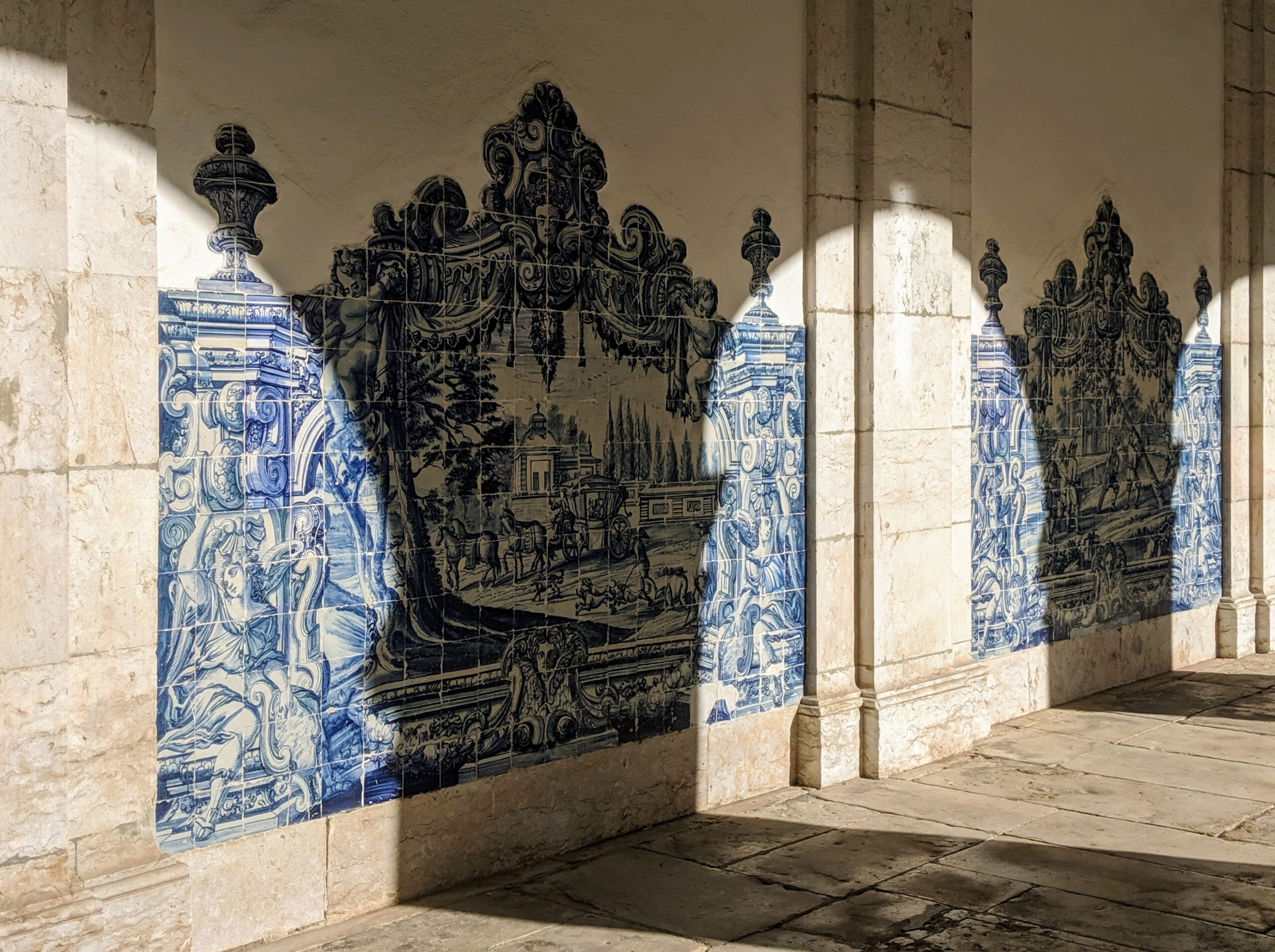
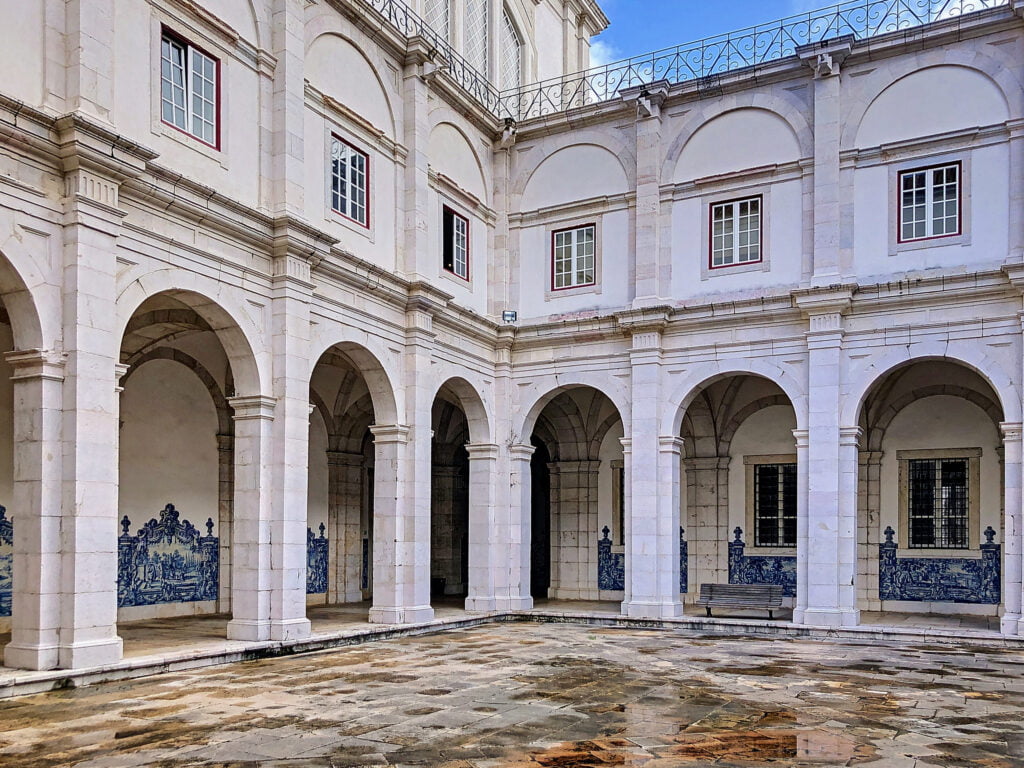
The monastery’s ordonnance was the former main entrance of the building, and as such, it boasts one of the most lavishly adorned spaces. Inside, you’ll find a ceiling adorned with a captivating trompe-l’œil painting by Vincenzo Baccarelli in 1710. The walls are adorned with panels of azulejos, one of which depicts the siege of Lisbon in 1147, while the floor showcases a stunning blend of pink and gray marble.
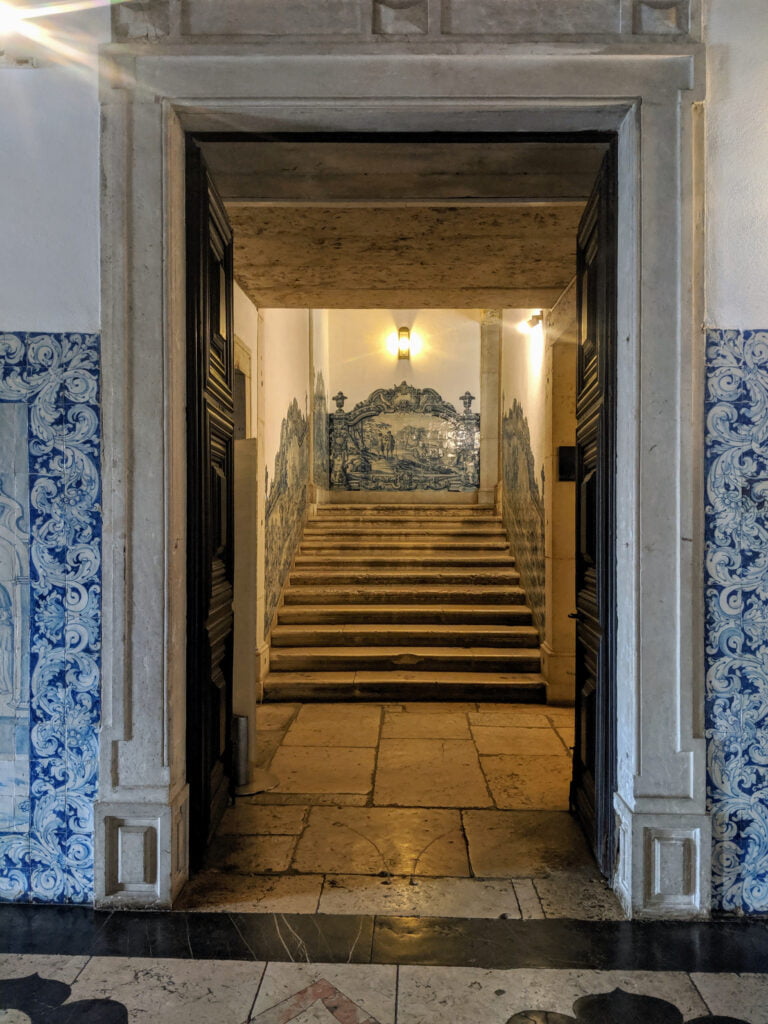
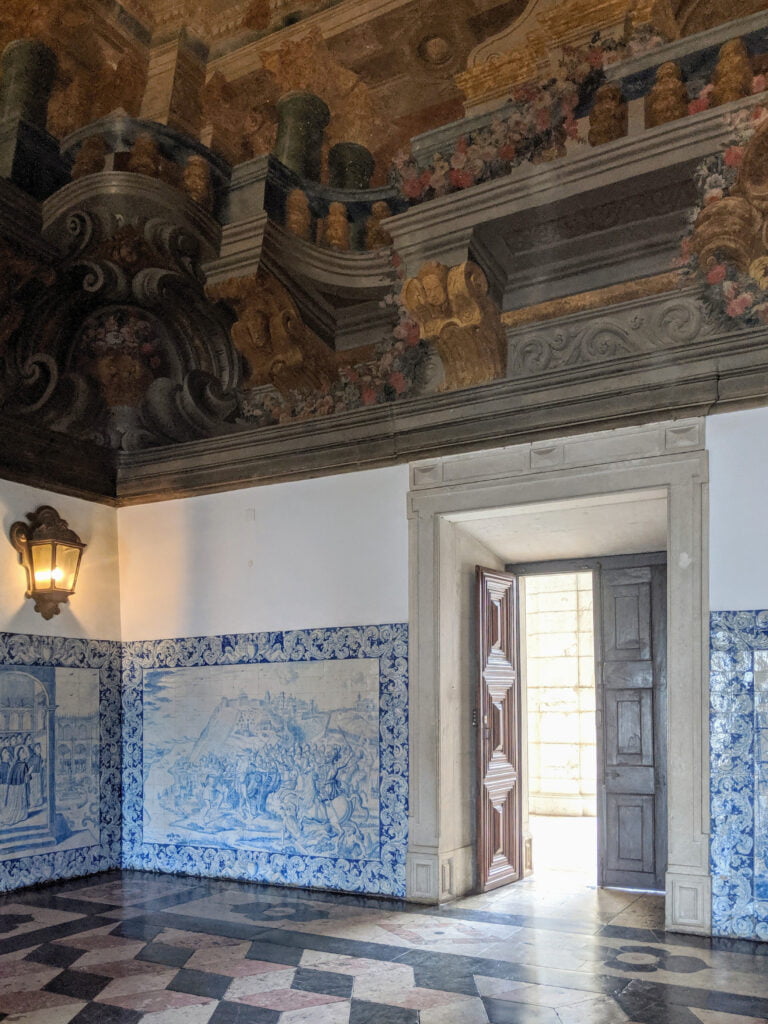
However, the entrance hall is not the only place where azulejos can be admired, as the monastery boasts nearly 220 panels comprised of over 100,000 azulejos, making it the world’s largest collection of baroque azulejos.
Another unique aspect is the depiction of La Fontaine’s fables in azulejos! From the 18th to the 20th century, the cloister arcades were closed and adorned with 38 azulejos panels illustrating the fables of Jean de La Fontaine. When the cloisters reopened, the panels were removed and restored for display in the monastery. To this day, the reasoning behind choosing this theme for the monastery’s decoration remains a mystery.
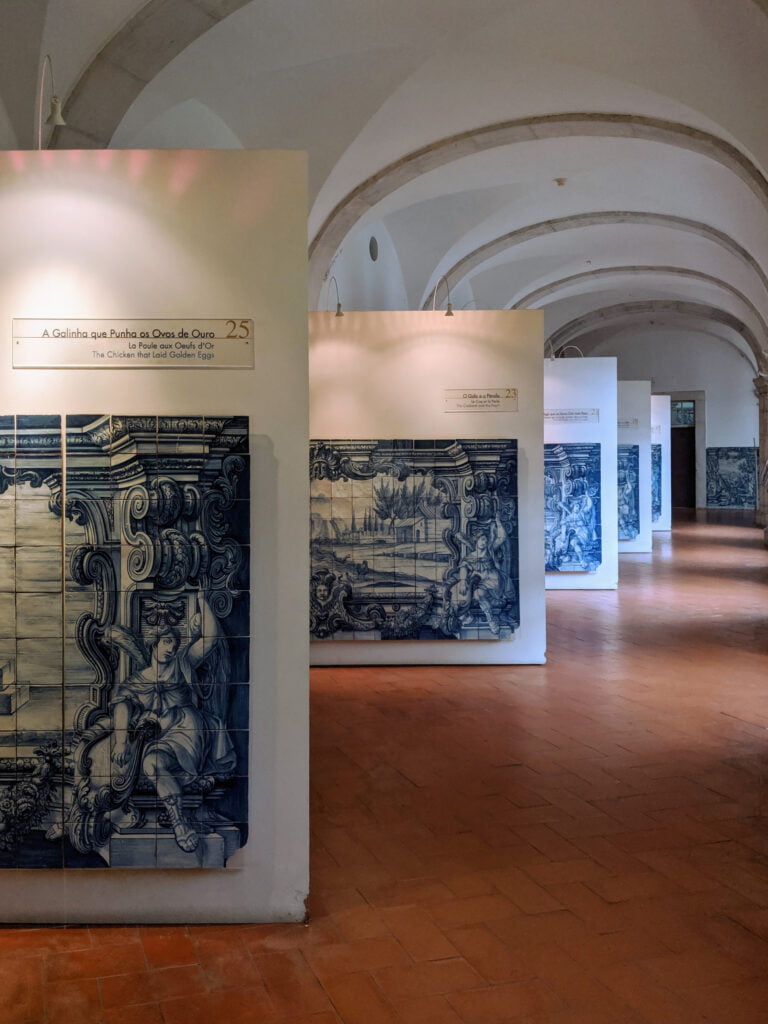
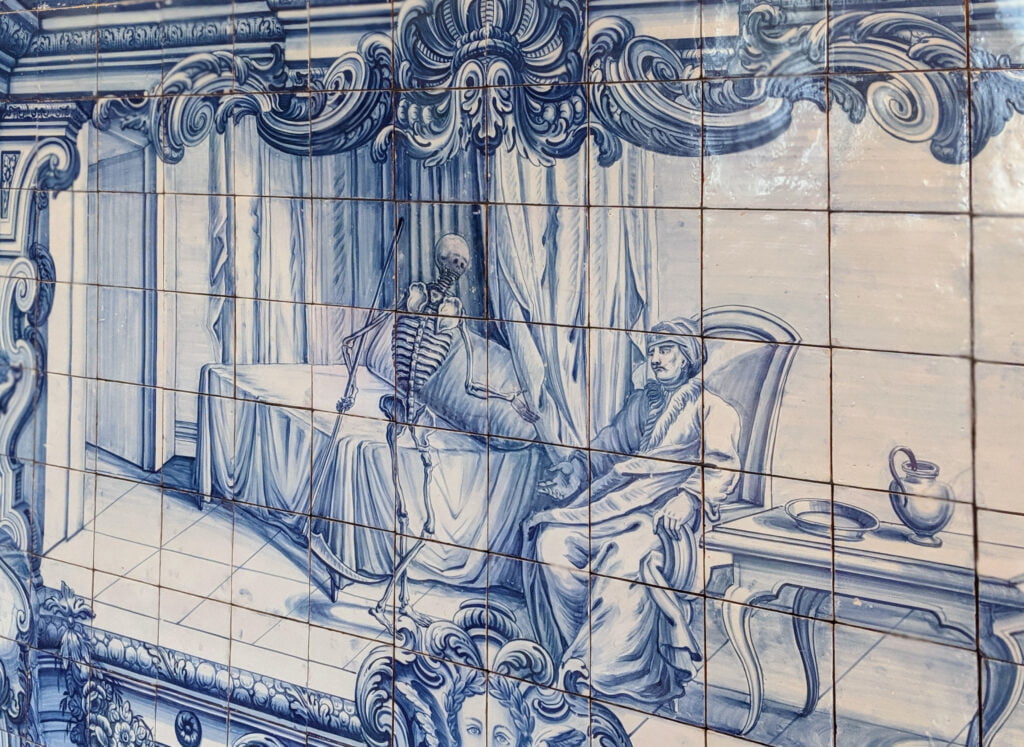
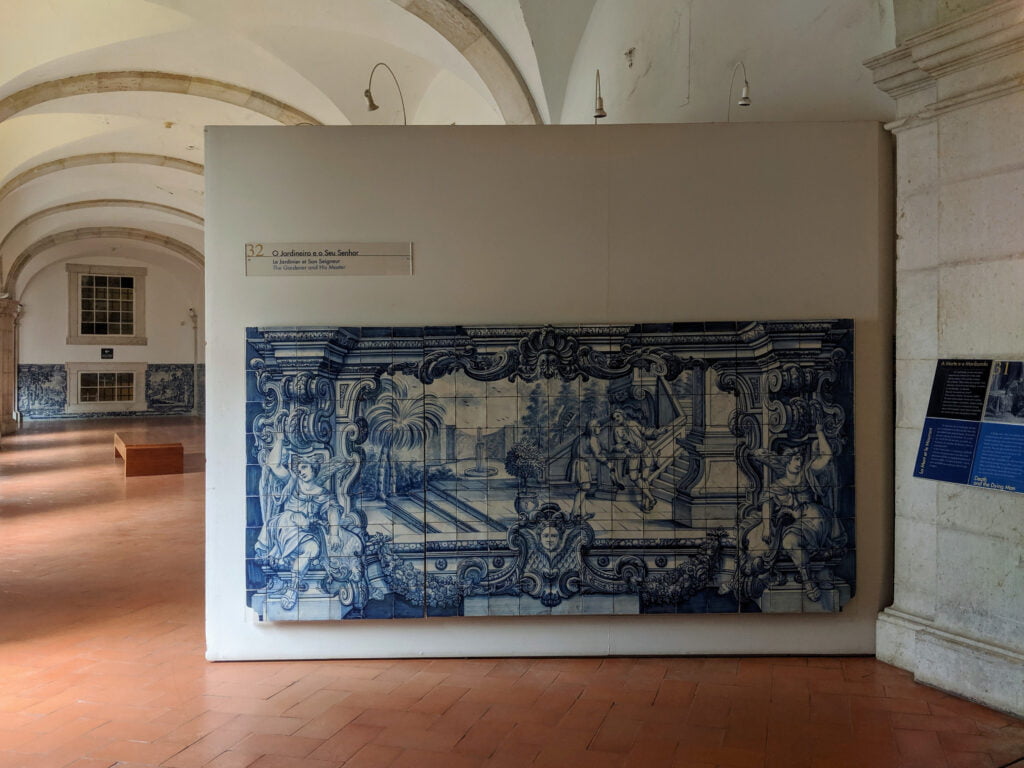
Next to the monastery cloisters, the former monks’ refectory was transformed in the 19th century into the Royal Pantheon for the Braganza dynasty. This majestic pantheon houses the remains of 59 members from the second Braganza house, a dynasty that ruled over Portugal from 1640 to 1910.
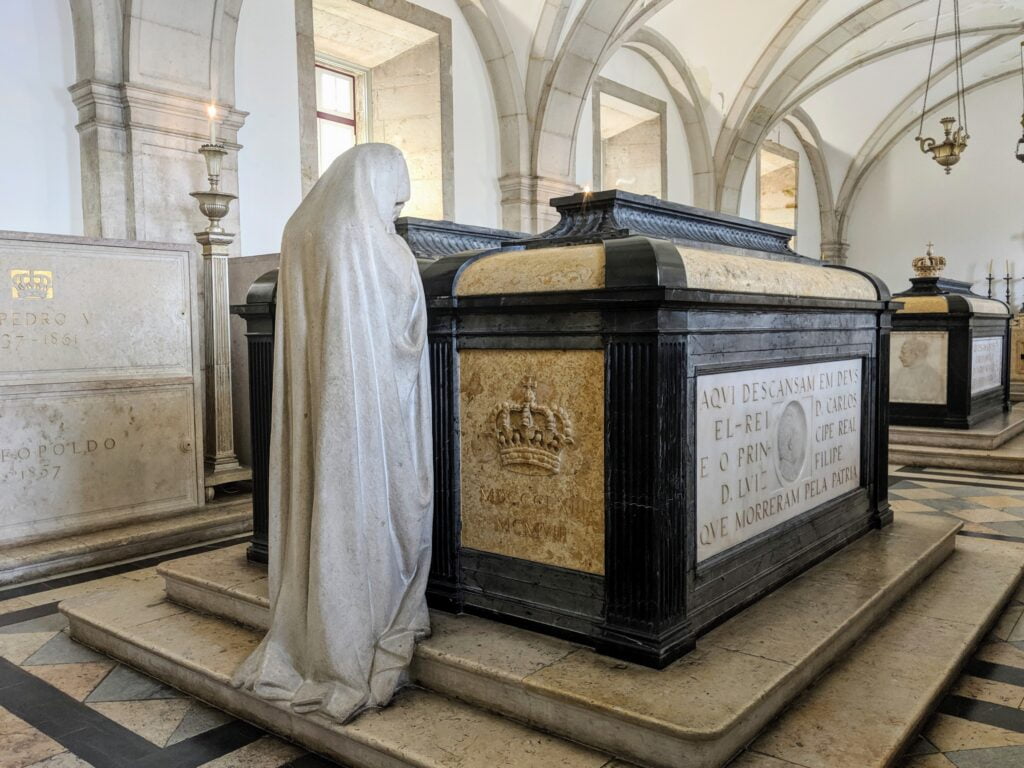
➜ Don’t miss out on the rooftop terrace of the monastery! It offers one of Lisbon’s most breathtaking views, with a 360º panoramic outlook of the city and the Tagus River. Make sure to include this visit in your itinerary for an unforgettable experience 🤩
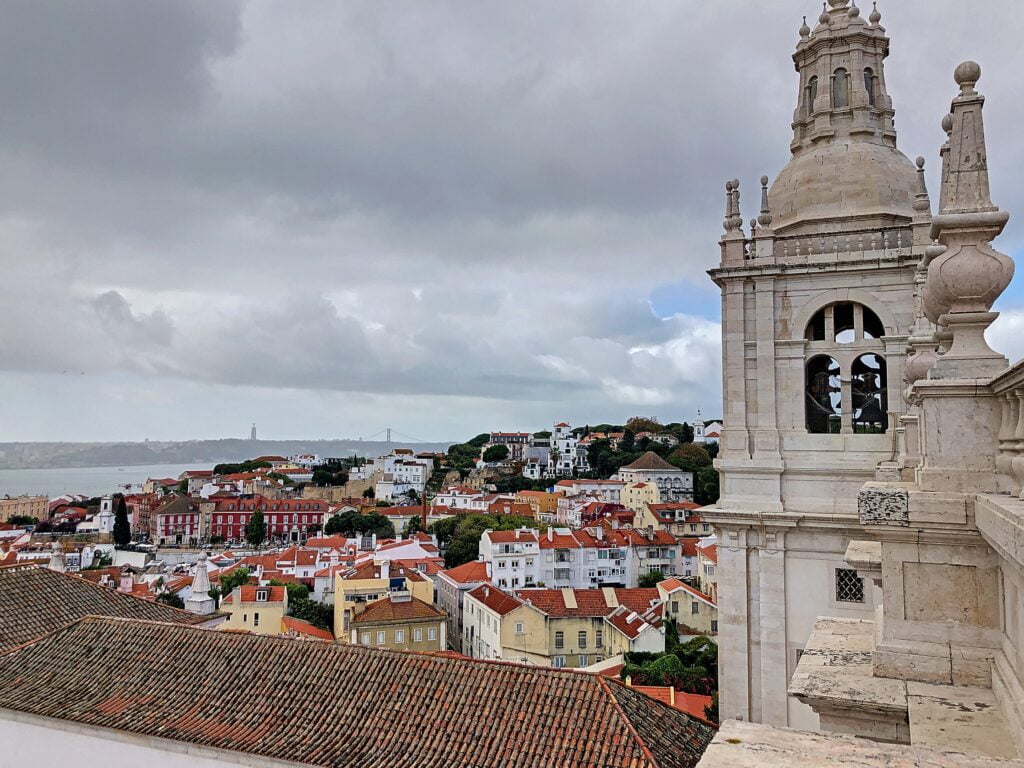

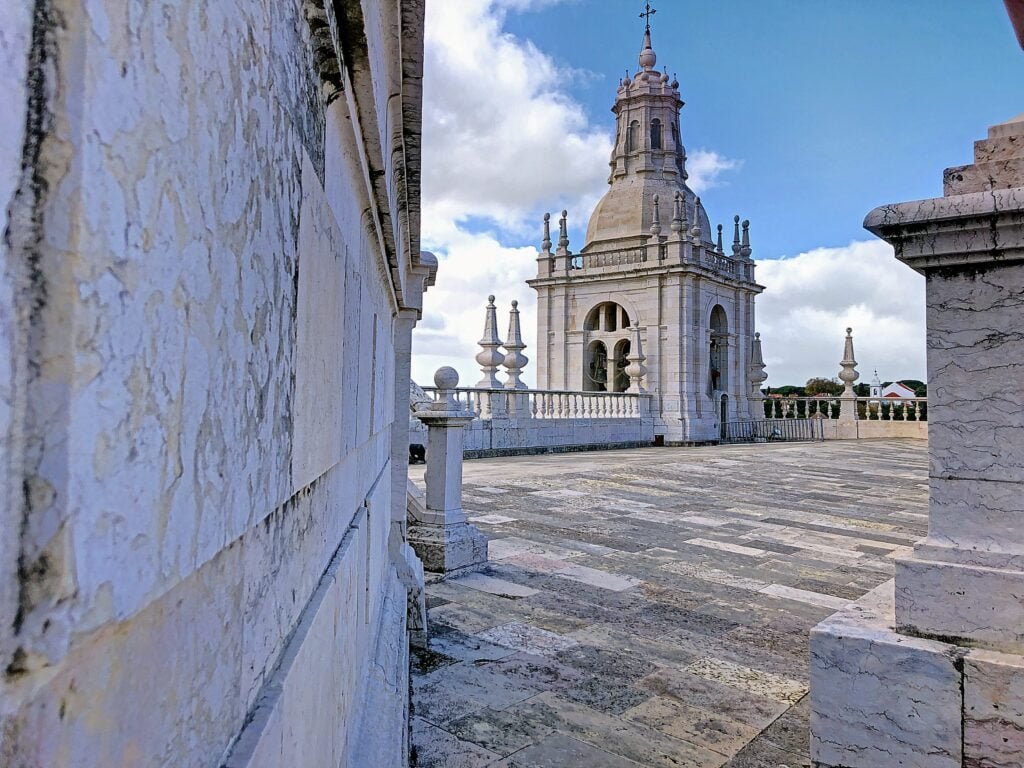

Originally occupied by nuns of the Order of Clarisses until 1834, the building now serves as a monastery, home to a male religious community. However, the monastery premises are open, inviting visitors to explore its fascinating history and architecture.
Helpful information
- Located at Largo de São Vicente, the São Vicente de Fora Monastery is conveniently reachable by taxi, bus, tram, or on foot while strolling through the Alfama neighborhood.
- The monastery welcomes visitors daily from 10:00 AM to 6:00 PM (last admission at 5:00 PM). Please note that the monastery remains closed on specific dates, including January 1st, Easter Monday, May 1st, and December 25th.
- The ticket price for adults is €5.
- Various guided tours are available on-site. Visit the website for further information.
Passing through the majestic Arco Grande de Cima, one descends towards the vibrant Santa Clara market. In this vicinity, several houses showcase exquisite azulejos facades, with Casa dell’Arte Club House being a prominent example.
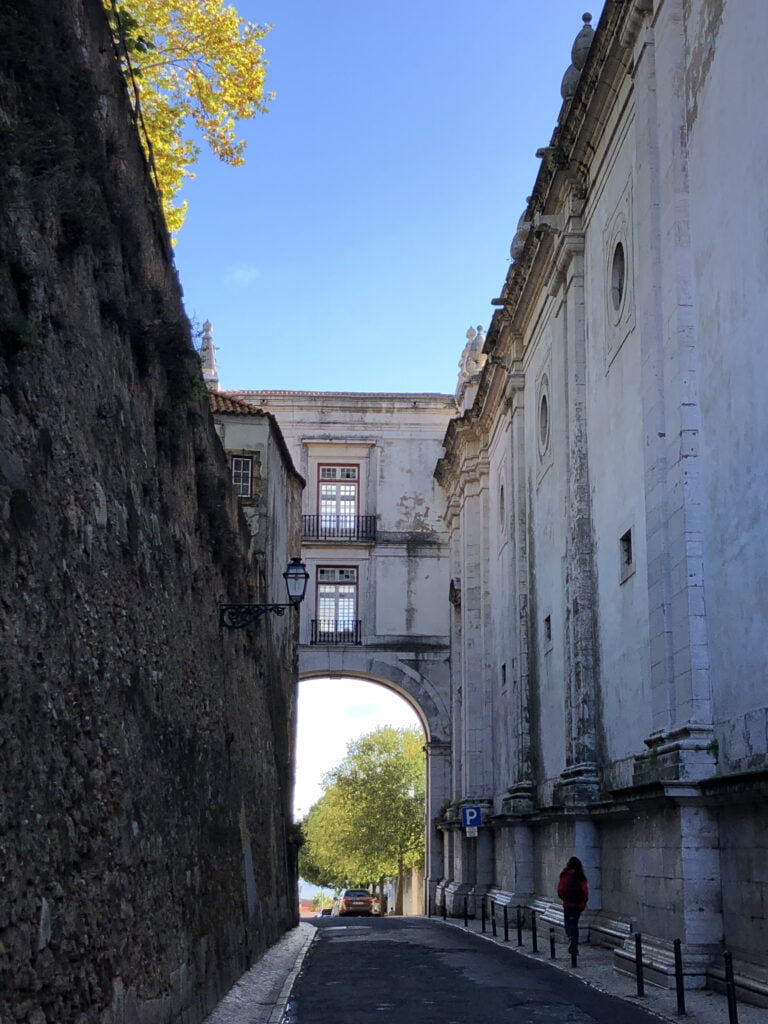
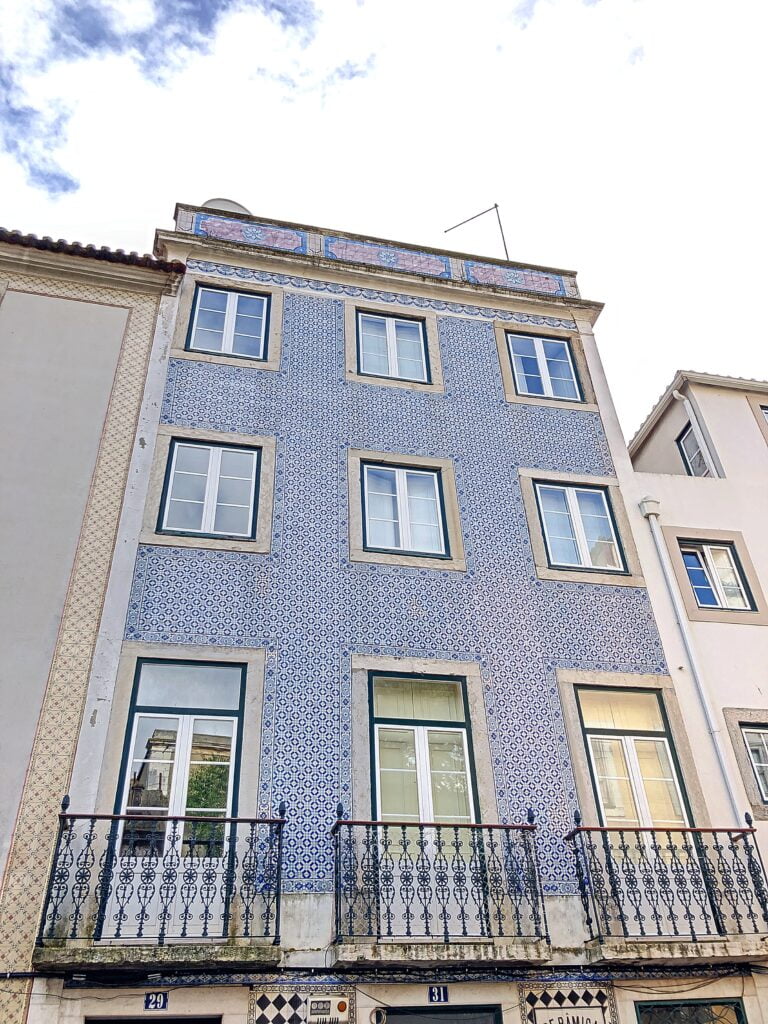
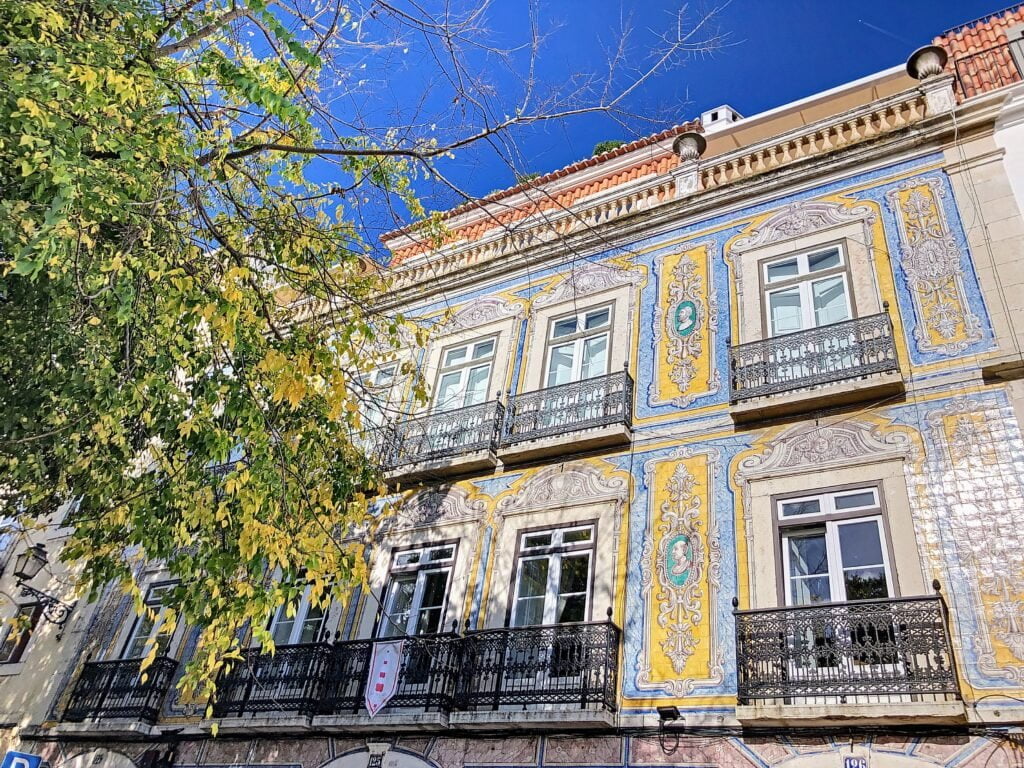
Mercado de Santa Clara
Santa Clara Market (Mercado de Santa Clara) is a charming covered market in the Alfama district between the São Vicente de Fora monastery and the National Pantheon. Since its inauguration in 1877, the building has undergone various renovations while preserving its traditional character. On the vendors’ stalls, fresh produce, local delicacies, flowers, handicrafts, and souvenirs await tourists and city dwellers, offering a delightful experience.
Campo de Santa Clara also has a renowned flea market called Feira da Ladra, which translates to “Thieves’ Market”. Dating back to the 13th century, it is Lisbon’s oldest and most famous market. After being situated in various locations, it settled in Campo de Santa Clara in 1903. You can find many items in this vibrant and authentic atmosphere, ranging from second-hand clothes to furniture, books, and vinyl records.
Helpful information
- The “Feira da Ladra” typically takes place on Tuesdays and Saturdays, from 9 am to 6 pm.
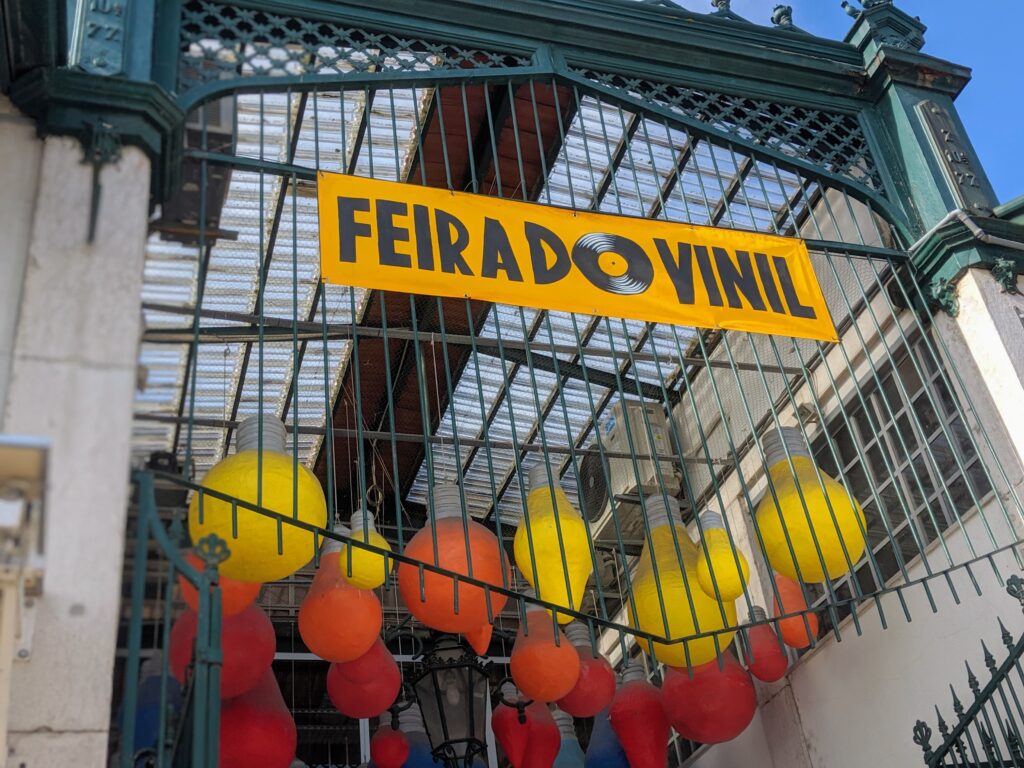
On the way to Miradouro da Graça, along Travessa de São Vicente, a mural by Mr. Dheo and Pariz One portrays the Carnation Revolution that overthrew Salazar on April 25, 1974. Created in 2014 on the walls of a primary school, this artwork cleverly incorporates elements of popular childhood culture in a satirical manner.
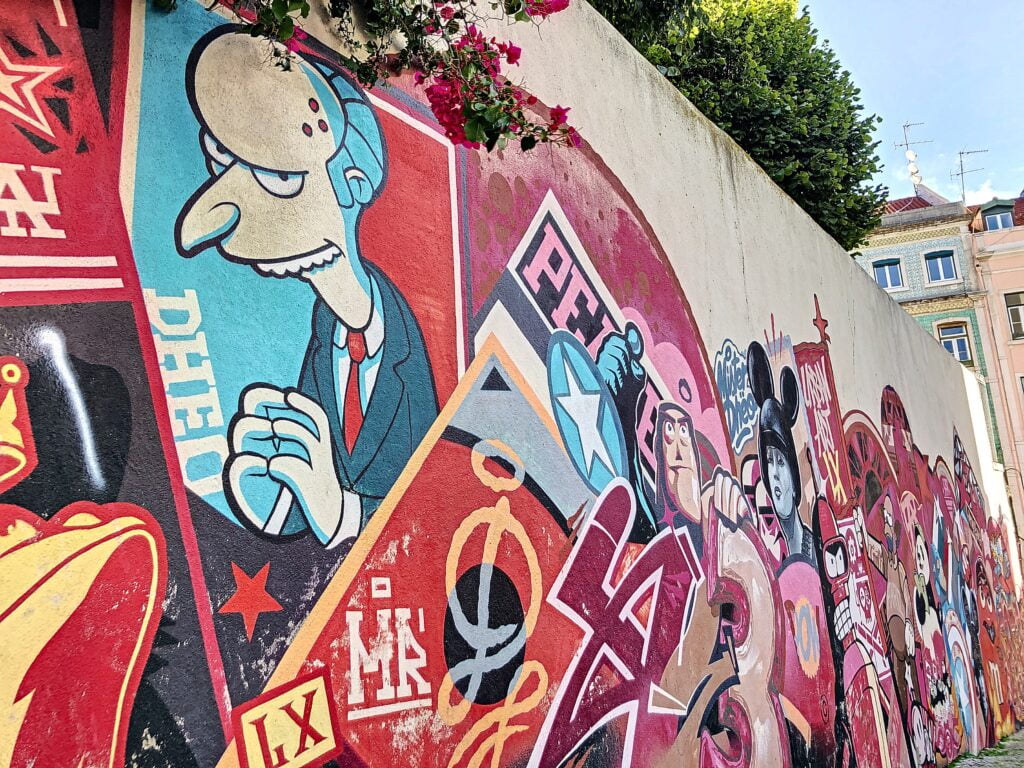
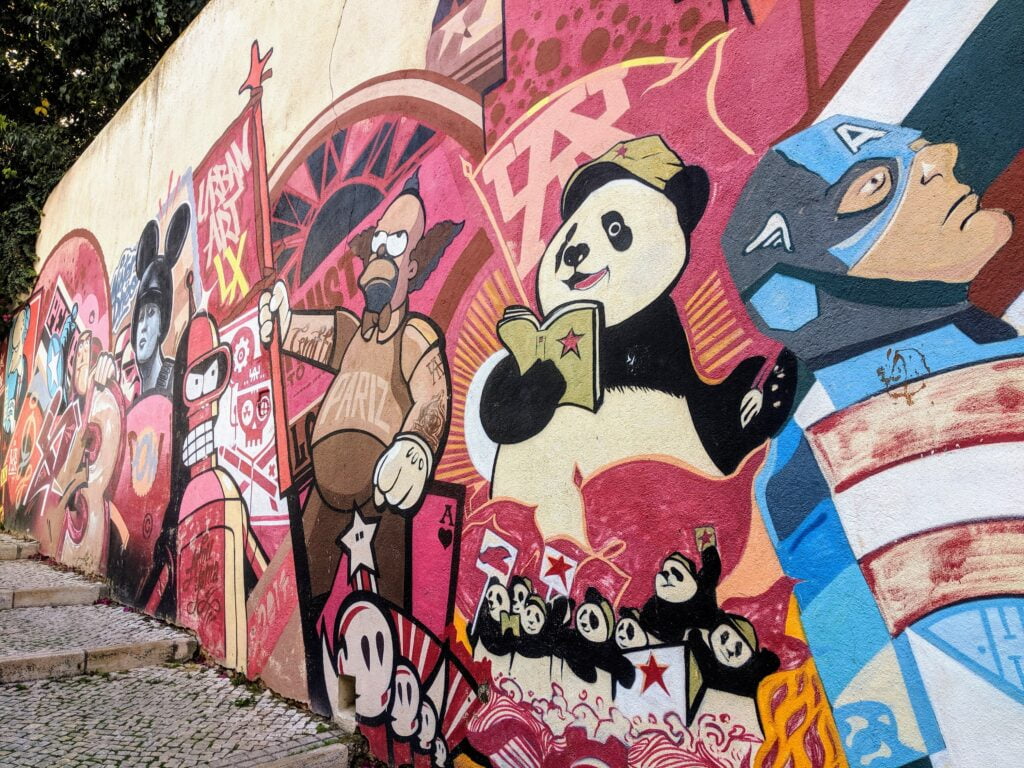
At the end of the street, near Graça Church (Igreja da Graça), lies Jardim da Graça, a lush green space that offers a beautiful panoramic view of Lisbon.
Igreja Paroquial da Graça
The Parish Church of Graça (Igreja Paroquial da Graça) is atop the Graça hill, near the lookout of the same name. Built-in the 13th century, the church has undergone renovations and expansions throughout the centuries, including Baroque elements in the 17th and 18th centuries.
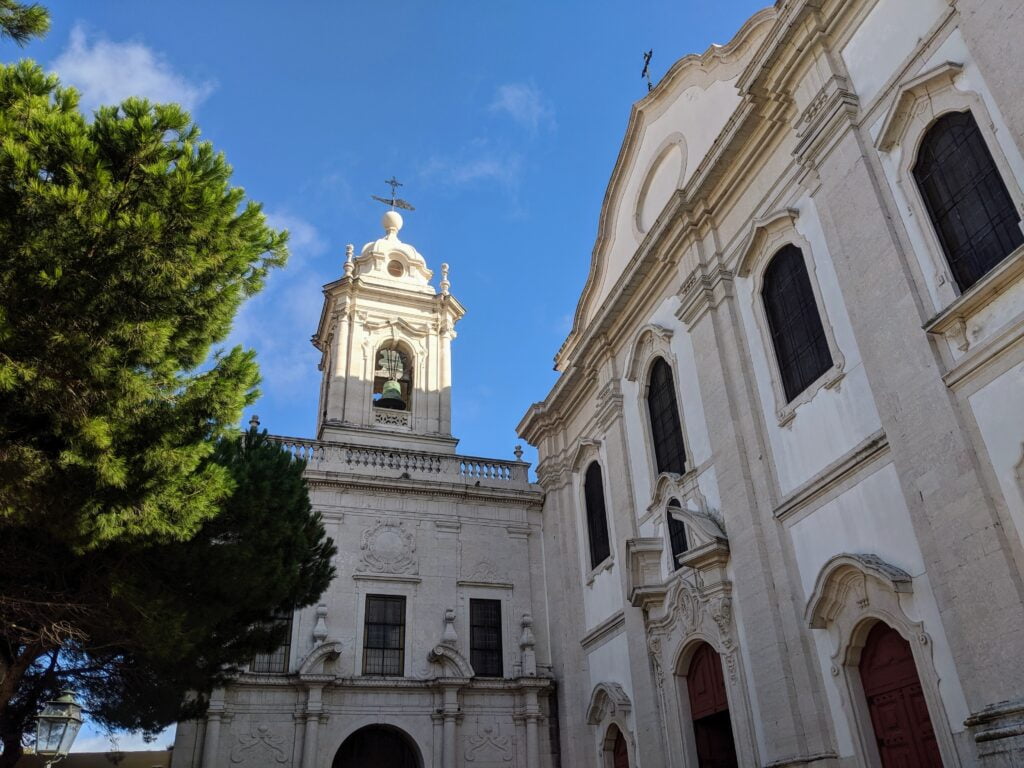
Miradouro da Graça
Still hosting masses and religious celebrations, the church is particularly renowned among tourists for its observation deck (miradouro da Graça), which provides magnificent panoramic views of São Jorge Castle, the Tagus River, and the city rooftops.
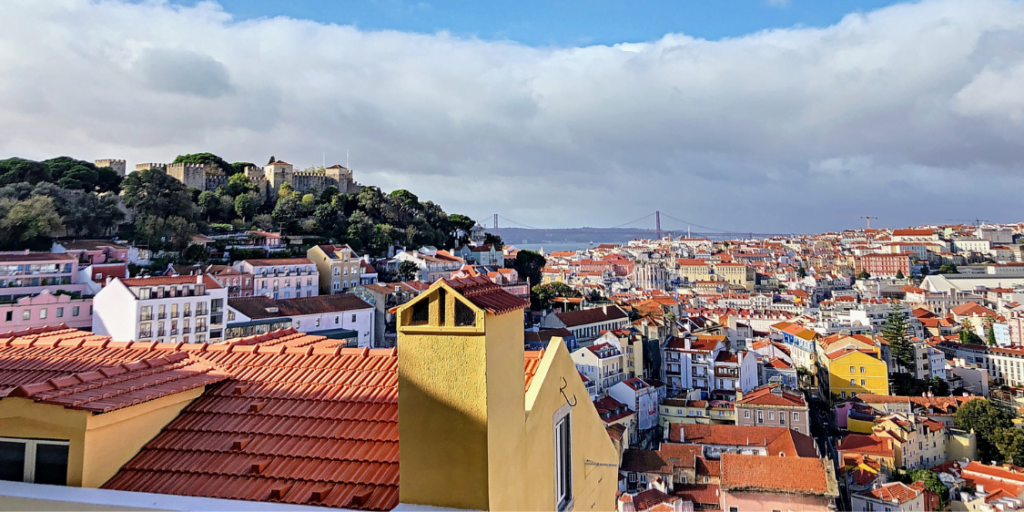
Castelo de São Jorge
Perched on a hill just a few hundred meters below, the São Jorge Castle (castelo São Jorge) stands as an iconic monument and an unmissable landmark in Lisbon.
Although its exact origins remain unclear, the castle’s history is believed to date back to Roman times. Expanded and fortified by the Moors in the 9th century, it became a royal residence and fortress after the Christian reconquest of Lisbon in 1147. The castle blends Moorish, Roman, and Gothic elements in a captivating architectural ensemble.
➜ Except for medieval military architecture enthusiasts, the São Jorge Castle doesn’t hold much appeal. However, the panoramic view from there is truly breathtaking.
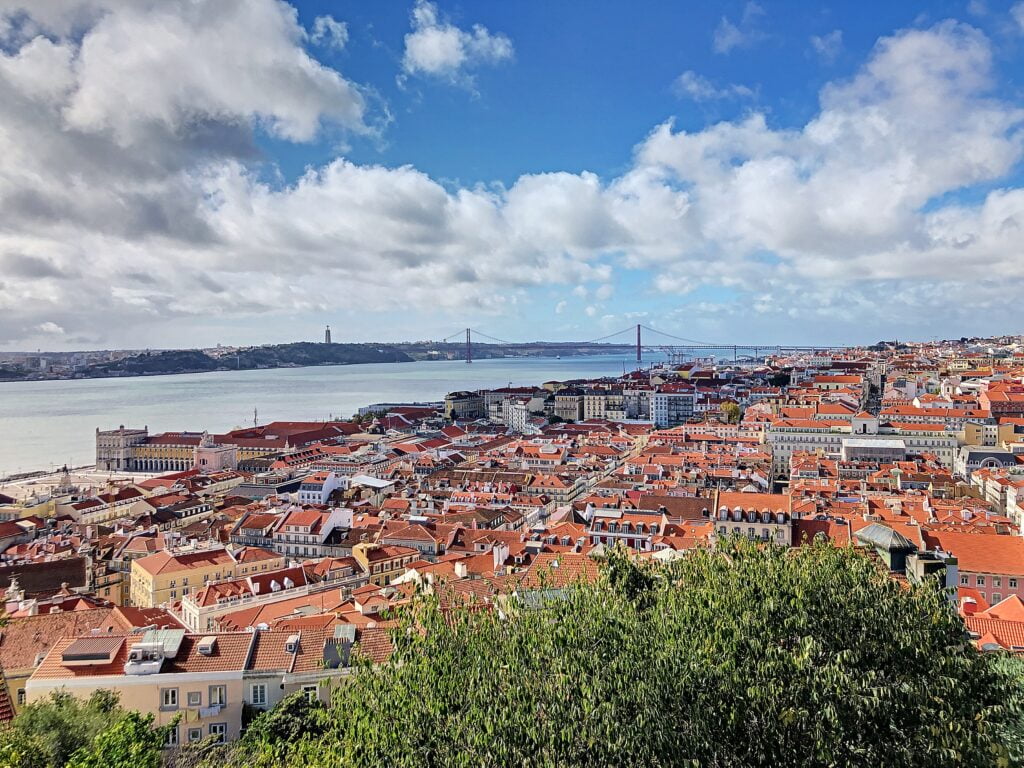
Helpful information
- São Jorge Castle welcomes visitors daily from 9 am to 6 pm, extending to 9 pm from March to October.
- The ticket price is 8,5€.
Our final stop is the Patio de dom Fradique, located right next to miradouro do Recolhimento, where we explore several captivating street art pieces. One of the highlights is the stunning mural by Mikael Omik, which provides a unique perspective of the São Jorge castle.
